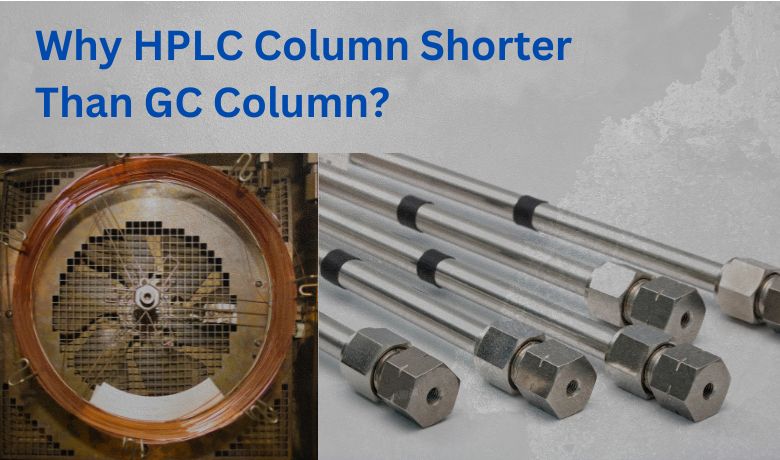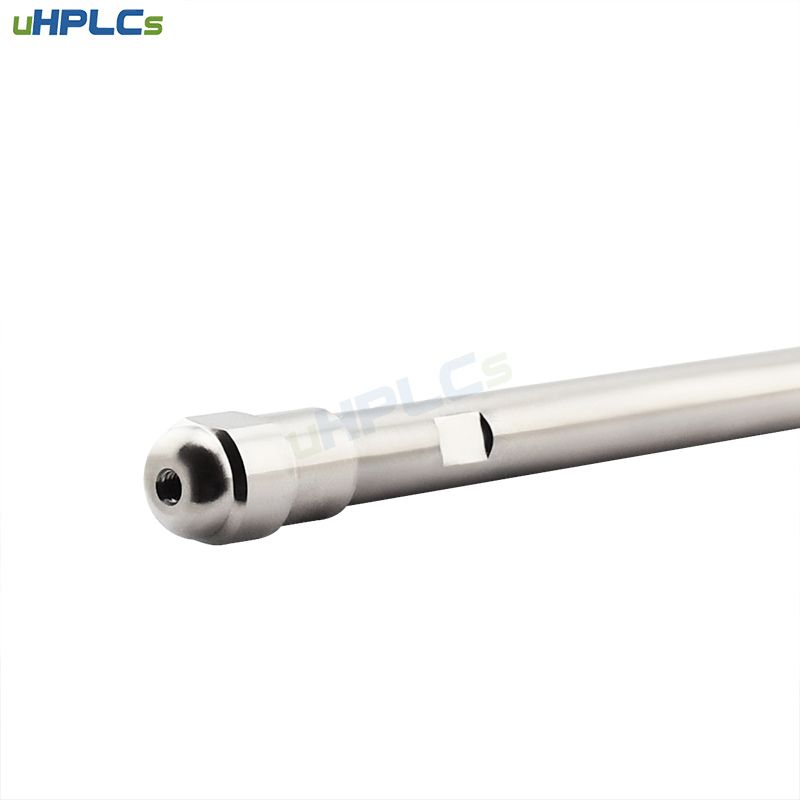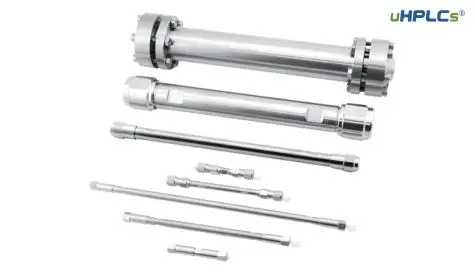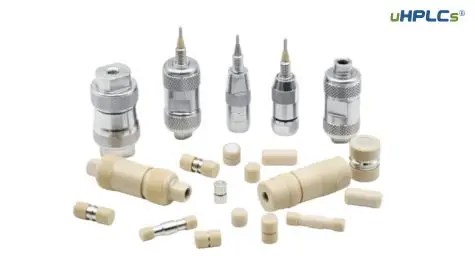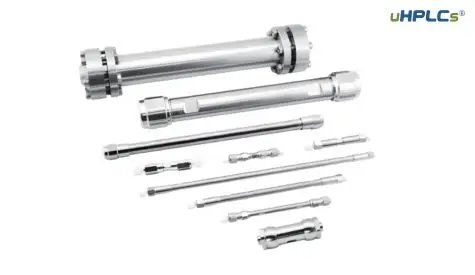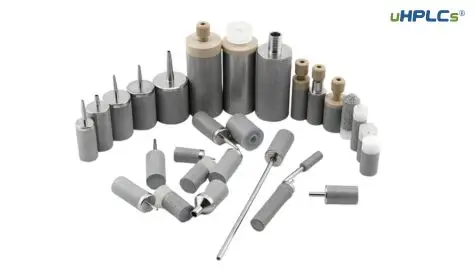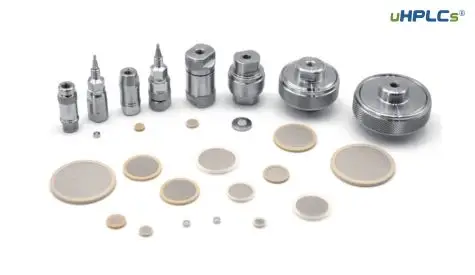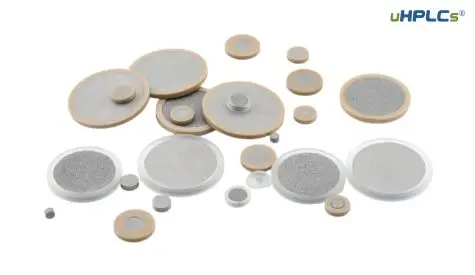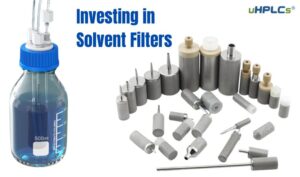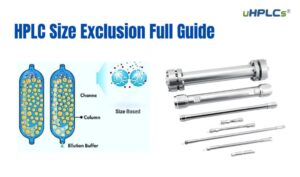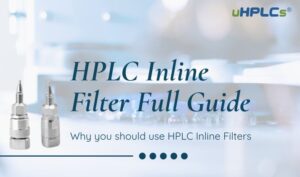Chromatography is a powerful technique used to separate mixtures into their individual components. It works by passing a mixture (sample) in a liquid or gas form (mobile phase) through a stationary phase (a packed column or a coated surface). The components of the mixture interact differently with the stationary phase, causing them to travel at different speeds. This differential migration allows separation to occur, with each component exiting the column (or reaching the end of the surface) at a specific time.
There are various types of chromatography, but two of the most important in analytical chemistry are:
High-Performance Liquid Chromatography (HPLC): Here, the mobile phase is a liquid solvent and the sample is dissolved in it. HPLC is widely used for separating and analyzing a broad range of non-volatile and thermally labile compounds, such as pharmaceuticals, proteins, and food components.
Gas Chromatography (GC): In GC, the mobile phase is an inert gas, and the sample needs to be volatile (easily vaporized) for analysis. GC excels at separating and identifying volatile organic compounds (VOCs), including environmental pollutants, petroleum products, and flavors in food.
Why Explore Column Length Differences?
This blog delves into the intriguing question of why HPLC columns are typically much shorter than GC columns. Even though both techniques achieve separation, the optimal column lengths differ significantly. We’ll explore the underlying reasons behind this difference, considering factors like the nature of the mobile phase, sample properties, and pressure limitations in each technique.
The Basics Information of HPLC and GC
1. High-Performance Liquid Chromatography (HPLC):
Principle:
- HPLC separates mixtures by dissolving the sample in a liquid solvent (mobile phase) and pumping it through a column packed with stationary phase particles.
- The components of the mixture interact differently with the stationary phase, causing them to travel at varying speeds.
- This differential migration separates the components, which are then detected as they exit the column.
Applications:
- HPLC is incredibly versatile and can analyze a wide range of non-volatile and thermally labile (heat-sensitive) materials, including:
- Pharmaceuticals (drugs)
- Proteins and peptides
- Food components (vitamins, flavors)
- Polymers
- Environmental pollutants (pesticides)
- HPLC is incredibly versatile and can analyze a wide range of non-volatile and thermally labile (heat-sensitive) materials, including:
2. Gas Chromatography (GC):
Principle:
- GC separates mixtures by vaporizing the sample and injecting it into a hot column containing a stationary phase.
- An inert gas (mobile phase) carries the vaporized sample through the column.
- Similar to HPLC, components in the mixture interact differently with the stationary phase, leading to separation based on their travel times.
Applications:
- GC excels at analyzing volatile organic compounds (VOCs) that can be easily vaporized without decomposition. Common applications include:
- Environmental analysis (air pollutants, soil contaminants)
- Petroleum products (crude oil, gasoline)
- Forensic analysis (evidence identification)
- Food and beverage flavors
- Breath analysis (medical diagnostics)
- GC excels at analyzing volatile organic compounds (VOCs) that can be easily vaporized without decomposition. Common applications include:
Here’s a table summarizing the key differences between HPLC and GC:
| Feature | HPLC | GC |
|---|---|---|
| Mobile Phase | Liquid solvent | Inert gas (e.g., He, N₂) |
| Sample Properties | Non-volatile, thermally labile | Volatile |
| Typical Applications | Pharmaceuticals, proteins, food | Environmental pollutants, petroleum, flavors |
| Column Length | Shorter (cm to dm range) | Longer (meters |
Understanding Column Length in Chromatography
The Column’s Role:
The column in chromatography acts as the battleground for separation. It’s a packed tube filled with stationary phase particles (HPLC) or coated with a stationary phase (GC). The mobile phase carrying the sample mixture interacts with this stationary phase, causing the components to separate based on their unique affinities.
Factors Influencing Column Length Choice:
Choosing the optimal column length is crucial for achieving effective separation in chromatography. Here are some key factors that influence this decision:
Efficiency: A longer column provides more opportunities for interaction between the sample components and the stationary phase. This can theoretically lead to higher separation efficiency, meaning sharper peaks on the chromatogram (detector output) and better resolution of closely eluting components.
Resolution: Resolution refers to the degree of separation between two closely eluting peaks. A longer column generally improves resolution, allowing you to distinguish between components with very similar properties.
Analysis Time: There’s a trade-off between efficiency/resolution and analysis time. Longer columns require more time for the mobile phase and sample components to travel through, resulting in longer analysis times.
Pressure: Especially in HPLC, using a longer column increases the backpressure on the system as the mobile phase encounters more resistance. Pumps have a pressure limit, and exceeding it can damage the instrument.
The Intriguing Case of HPLC vs. GC:
As we saw earlier, HPLC columns are typically much shorter (centimeters to decimeters) compared to GC columns (meters). This difference can be attributed to the factors mentioned above, particularly the nature of the mobile phase and pressure limitations.
Why HPLC Columns Are Shorter
In the previous section, we saw the importance of column length in chromatography and the factors influencing its choice. Now, let’s delve into the reasons behind the significant difference in column lengths between HPLC and GC.
The Viscosity Factor:
The key difference lies in the mobile phase. Liquids used in HPLC have a much higher viscosity compared to the inert gases used in GC. Viscosity refers to a fluid’s resistance to flow.
- Impact on Flow and Pressure: The higher viscosity of liquids in HPLC creates more resistance to flow through the column compared to the gas in GC. This translates to a significant pressure drop as the mobile phase pushes through a longer HPLC column.
Efficiency vs. Speed in HPLC:
Despite shorter columns, HPLC can achieve high separation efficiency. Here’s why:
- Smaller Stationary Phase Particles: HPLC columns typically employ smaller stationary phase particles compared to GC columns. These smaller particles provide a larger surface area for interaction between the sample and the stationary phase, compensating for the shorter column length.
- Higher Flow Rates: The pumps in HPLC systems can handle higher pressures, allowing for faster flow rates of the mobile phase through the column. This helps maintain good separation efficiency even with shorter columns.
Pressure Limitations in HPLC:
There’s a physical limit to the pressure an HPLC system can handle. Exceeding this limit can damage the pump and other components. Since longer columns create higher backpressure, HPLC systems often rely on shorter columns to stay within safe operating pressure ranges.
Material and Cost Considerations:
- HPLC Columns: HPLC column materials, particularly those for high-performance applications, can be expensive. Shorter columns translate to lower material costs.
- GC Columns: GC columns, while often longer, are generally simpler in design and use less specialized materials, making them potentially less expensive than high-performance HPLC columns.
In conclusion, the choice of column length in chromatography is a balance between achieving optimal separation efficiency, analysis speed, and staying within the pressure limitations of the system. The contrasting mobile phases (liquid vs. gas) and the pressure limitations in HPLC contribute significantly to the shorter column lengths typically used in this technique compared to GC.
Impact of Column Length on Analytical Performance
Now that we understand the reasons behind different column lengths in HPLC and GC, let’s delve deeper into how column length specifically affects analytical performance. Here, we’ll compare the impact on resolution, sensitivity, and speed in both techniques, followed by practical considerations for choosing the right column length in your lab.
Resolution vs. Column Length:
- HPLC: Longer columns generally improve resolution in HPLC by providing more interaction sites for separation. However, the pressure limitations often necessitate shorter columns. Optimizing particle size and mobile phase composition becomes crucial to achieve good resolution with shorter HPLC columns.
- GC: GC columns are typically longer, allowing for excellent resolution of complex mixtures. The lower viscosity of the gas mobile phase minimizes pressure limitations, allowing for efficient separation with longer columns.
Sensitivity vs. Column Length:
- HPLC: Shorter columns can sometimes offer slightly higher sensitivity in HPLC due to faster analysis times. Less time spent in the column reduces the possibility of sample loss due to interactions with the stationary phase or decomposition.
- GC: Similar to HPLC, shorter columns in GC might offer a slight sensitivity advantage due to faster analysis. However, achieving good sensitivity in GC often relies on optimizing detector response and injection techniques.
Speed vs. Column Length:
- HPLC: Shorter columns lead to faster analysis times in HPLC, a significant advantage for high-throughput workflows. Optimizing flow rates can further enhance speed without compromising separation efficiency.
- GC: The longer columns in GC typically result in longer analysis times. However, GC offers inherent speed advantages due to the lower viscosity of the gas mobile phase, allowing for faster flow rates through the column.
Choosing the Right Column Length in Practice:
In a laboratory setting, the ideal column length for your chromatography experiment requires careful consideration of several factors:
- Complexity of the Sample Mixture: Complex mixtures with many closely eluting components might benefit from a longer column (HPLC) or a high-resolution GC column for better separation.
- Required Sensitivity: If high sensitivity is paramount, a shorter column in HPLC or optimizing injection techniques in GC could be considered.
- Analysis Time Constraints: For time-sensitive analyses, shorter columns in HPLC or faster GC methods using shorter columns might be preferable.
- Instrument Capabilities: The pressure limitations of your HPLC system should be considered when choosing column length.
Remember, there’s often a trade-off between achieving optimal resolution, sensitivity, and speed. By understanding the impact of column length and the specific requirements of your analysis, you can make informed decisions to achieve the best possible results in your chromatography experiments.
Summarize
Are you ready to explore the vast possibilities that HPLC columns offer for your analytical needs?
Whether you’re looking to achieve unparalleled separation efficiency, reduce analysis times, or navigate the complexities of choosing the right column, we’re here to help.
Dive deeper into our selection of HPLC columns and discover how our cutting-edge solutions can enhance your laboratory’s capabilities.
For more information and to get pricing details, don’t hesitate to reach out to us at sales@uhplcs.com.
Let’s unlock the full potential of your chromatographic analysis together!

